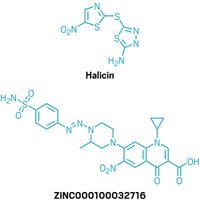Advertisement
Grab your lab coat. Let's get started
Welcome!
Welcome!
Create an account below to get 6 C&EN articles per month, receive newsletters and more - all free.
It seems this is your first time logging in online. Please enter the following information to continue.
As an ACS member you automatically get access to this site. All we need is few more details to create your reading experience.
Not you? Sign in with a different account.
Not you? Sign in with a different account.
ERROR 1
ERROR 1
ERROR 2
ERROR 2
ERROR 2
ERROR 2
ERROR 2
Password and Confirm password must match.
If you have an ACS member number, please enter it here so we can link this account to your membership. (optional)
ERROR 2
ACS values your privacy. By submitting your information, you are gaining access to C&EN and subscribing to our weekly newsletter. We use the information you provide to make your reading experience better, and we will never sell your data to third party members.
Computational Chemistry
Artificial intelligence predicts a target for treating fibrosis and finds a compound to do it
Insilico Medicine announces preclinical trials for drug candidate
by Sam Lemonick
February 25, 2021
| A version of this story appeared in
Volume 99, Issue 7

Claiming it has achieved a first in drug discovery, Insilico Medicine says it will begin preclinical trials with a novel compound discovered by artificial intelligence; the drug candidate is aimed at a novel target discovered by AI. The biotech firm isn’t revealing the compound or the target but says the small molecule compares favorably to an existing drug for treating idiopathic pulmonary fibrosis (IPF) in mice and in vitro.
Insilico also emphasizes the efficiency of its process, claiming that it took 18 months and about $2.6 million to identify the target and discover a preclinical candidate. The company is marketing the AI-based software packages used to find the target and the molecule, packages several large pharmaceutical companies are now testing.
Insilico attracted attention and some skepticism in 2019 when it announced it had used AI to sift through databases and identify a molecule predicted to inhibit discoidin domain receptor 1 (DDR1), a kinase linked to fibrosis (Nat. Biotech. 2019, DOI: 10.1038/s41587-019-0224-x). Pulmonary fibrosis is scarring and thickening of lung tissue that makes breathing difficult. At the time, some experts praised Insilico for its speed. Others questioned the value of the feat. Some pointed out that it was hard to know if a human could have found the molecule as fast or faster.

In a press briefing, Insilico CEO Alex Zhavoronkov described using two separate software packages to find the new drug target and to propose a previously unknown molecule effective against it. The first, PandaOmics, used AI and informatics tools to identify biomarkers of lung fibrosis. It also used text-mining AI to search for other clues about the target and try to establish its novelty. Having chosen the target, Insilico used the second package, Chemistry42, which incorporates recurrent neural networks, genetic algorithms, and generative adversarial networks—including some described in 2019—to predict new molecules that would be effective against that target.
Zhavoronkov said experiments had showed that Insilico’s candidate could be effective at treating fibrosis and that it had passed other tests for potential pharmaceuticals like toxicity and metabolic availability studies. He showed reporters data comparing the compound to nintedanib, a tyrosine kinase inhibitor prescribed to treat IPF. Insilico’s candidate operates by a different mechanism of action than nintedanib does, Zhavoronkov said, and in lab tests was more effective at lower doses for blocking the cellular changes associated with fibrosis. He also emphasized how quickly and cheaply the company had reached the doorstep of preclinical trials and noted a 2010 study that estimated a typical drug’s development takes 10 years and $2 billion (Nat. Rev. Drug Discovery 2010, DOI: 10.1038/nrd3078).
The comparison is far from perfect. That study did not include target identification but did include clinical trials, which medicinal chemist Derek Lowe points out account for the largest share of drug development costs. As for speed, Bernard Munos, a senior fellow at the think tank FasterCures, says he would call the announcement a breakthrough only if Insilico shows it can match that timeline for other targets. He says it may be that the firm’s methods work well just in this chemical space. Lowe suspects that Insilico’s drug candidate is another kinase inhibitor like nintedanib, which itself has limited efficacy. That approved drug only treats symptoms of fibrosis and does not improve survival in people with IPF. He wonders what advantages Insilico Medicine expects its candidate to show.
Big pharmaceutical companies aren’t waiting to see how this candidate pans out before investing in Insilico’s products. Zhavoronkov said five companies, including Pfizer and Syngenta, are using its software.




Join the conversation
Contact the reporter
Submit a Letter to the Editor for publication
Engage with us on Twitter